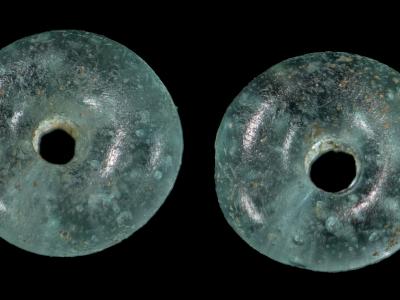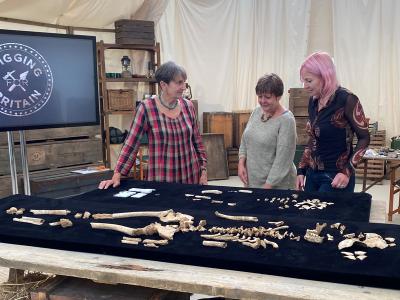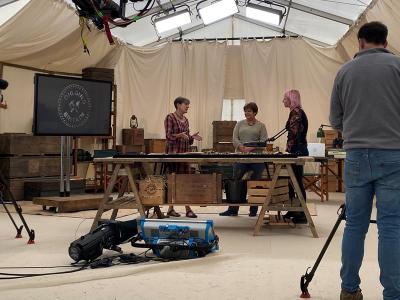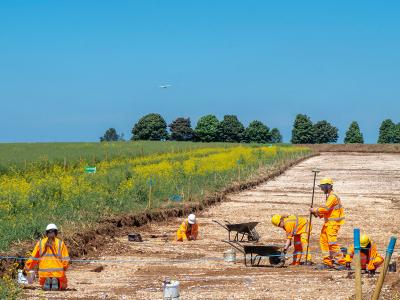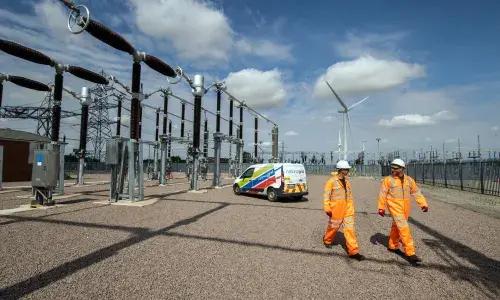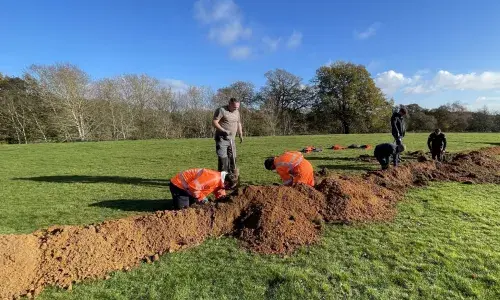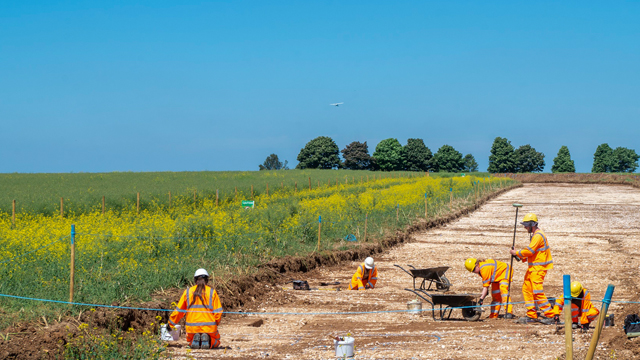
Anglo-Saxon cemetery discovered in Lincolnshire to appear on BBC’s Digging for Britain tomorrow
- Discoveries unearthed during the construction of the UK’s new Viking Link interconnector will be shown on television this week
- Items from an Anglo-Saxon cemetery were uncovered in rural Lincolnshire during work to build Viking Link
- Finds including jewellery, pottery and human remains will be featured on Tuesday’s episode of BBC2’s Digging for Britain at 8pm
Archaeological discoveries from an Anglo-Saxon cemetery, found underground in rural Lincolnshire, will appear on TV tomorrow evening, Tuesday 9 January, as part of BBC’s latest instalment of Digging for Britain.
The items – including jewellery, pottery and the remains of 23 people from Anglo-Saxon times – were found during the construction of Viking Link, the world’s longest land and subsea interconnector.
Viking Link, which went live on 29 December, is the world’s longest land and subsea interconnector and enables the sharing of electricity between the UK and Denmark.
Wessex Archaeology excavated the site and removed items for research and assessment.
The finds will appear in the show alongside presenter Professor Alice Roberts, who said: “The middle of the first millennium in Britain is a mysterious period – historical sources are thin on the ground. So any archaeological discoveries from this time are precious and help us to understand what was happening. These burials included some beautiful grave goods, but I can’t wait to find out more about the individuals themselves, with post-excavation analysis of the bones and teeth.”
Since 2020, 50 archaeological sites have been dug along the onshore cable route. The wealth of evidence recovered is shedding light on life across rural south-east Lincolnshire from prehistory to the present day, with highlights including a Bronze Age barrow and a Romano-British farmstead. The most striking discovery, however, is the remains of an Anglo-Saxon cemetery, which features in the BBC series.
Peter Bryant led the excavation work for Viking Link, which is a joint venture between National Grid and Danish system operator Energinet. He said: “I really enjoyed being part of the project. It was surprising how many artefacts we found across the route – the gold Anglo-Saxon pendant from the burial ground was a highlight as was the outreach with the local communities to share what we found. It has been very interesting and exciting to help unearth the hidden treasures that have lain dormant for hundreds of years, in such a careful way. It was a pleasure working with Wessex Archaeology on this journey through time."
The burials in the cemetery deliberately focus on an earlier Bronze Age ring ditch and indicate the funerary landscape was long established. Archaeologists uncovered the buried remains of 23 people alongside a range of grave goods including knives, jewellery and pottery vessels. From these 250 artefacts, experts know the cemetery dates to the 6th and 7th centuries AD.
Among the burials was that of a teenage girl and a child. Both lay on their sides with the child tucked in behind the older girl. Two small gold pendants set with garnets and a delicate silver pendant with an amber mount were recovered from around the teenager’s head or chest, together with two small blue glass beads and an annular brooch.
Jacqueline McKinley, Principal Osteoarchaeologist, Wessex Archaeology, said: “Although many Anglo-Saxon cemeteries are known in Lincolnshire, most were excavated decades ago when the focus was on the grave goods, not the people buried there. Excitingly, here we can employ various scientific advancements, including isotopic and DNA analyses. This will give us a far better understanding of the population, from their mobility to their genetic background and even their diet.”
The relationship between the child and the teenager is not yet known, but research and analysis are ongoing and will include isotope and Ancient DNA analysis of these and other skeletal remains. This will help to identify familial relationships and broader genetic links, both within this community and between others in the region, and the movement of people in wider society.
Specialists are also looking at the artefacts and the layout of the cemetery to learn about the economic, cultural and social factors affecting this community, including the import of exotic goods and the health of those buried within different parts of the cemetery.
As this research unfolds, the team from Wessex Archaeology hope to greatly extend our understanding of Anglo-Saxon life and death in the region.
A Roman Mystery and Waterloo’s Disappearing Dead Digging for Britain, BBC Two 8pm, Tuesday 9 January 2024 https://www.bbc.co.uk/programmes/m001ttqr Also available on iPlayer |
Notes to editors
Contacts
For more information or interviews, please contact:
Sara Revell
Media Officer, National Grid
07811 768024
[email protected]
or:
Nicola Kalimeris
Head of Communications at Wessex Archaeology
07927 590792
[email protected] or [email protected]
Images
A selection of images and footage is available to use for free for this story.
Please credit © Wessex Archaeology for images and footage.
About Viking Link
Viking Link is the world’s longest land and subsea interconnector stretching for 475 miles between the UK and Denmark, enabling the two countries to share electricity.
The link is a joint venture between National Grid and Danish system operator Energinet. It has a capacity of 1.4GW, which can provide enough electricity for up to 2.5 million UK homes.
Find out more about Viking Link
About National Grid Ventures
National Grid Ventures (NGV) operates outside of National Grid’s core regulated businesses in the UK and US, where it develops, operates and invests in energy projects, technologies and partnerships to accelerate the development of our clean energy future.
National Grid Ventures operates a diverse portfolio of energy assets across the UK and US, including subsea electricity interconnectors, competitive transmission, wind and solar generation, battery storage and LNG storage and regasification.
About National Grid
National Grid sits at the heart of Britain’s energy system, connecting millions of people and businesses to the energy they use every day. Our individual companies run the systems and infrastructure that deliver electricity across the country.
National Grid is pivotal to the energy systems in the UK and the north-eastern United States. We aim to serve customers well and efficiently, supporting the communities in which we operate and making possible the energy systems of the future.
National Grid in the UK
We own and operate the electricity transmission network in England and Wales, with day-to-day responsibility for balancing supply and demand. We also operate, but do not own, the Scottish networks. Our networks comprise approximately 7,200 kilometres (4,474 miles) of overhead line, 1,500 kilometres (932 miles) of underground cable and 342 substations.
Other UK activities mainly relate to businesses operating in competitive markets outside of our core regulated businesses; including interconnectors and a liquefied natural gas (LNG) importation terminal – all of which are now part of National Grid Ventures. National Grid Property is responsible for the management, clean-up and disposal of surplus sites in the UK. Most of these are former gas works.
Visit our Media Centre to find out more about the energy challenge and how National Grid is helping find solutions to some of the challenges we face.
National Grid undertakes no obligation to update any of the information contained in this release, which speaks only as at the date of this release, unless required by law or regulation.
About Wessex Archaeology
Bringing together leading minds and practitioners in the sector, Wessex Archaeology is a trusted archaeology and heritage service provider and educational charity. From our network of international offices, we work in partnership with our clients to deliver sustainable solutions to manage the historic environment – above ground, below ground and underwater. We are committed to our social impact. This means using the knowledge and connections we make through our commercial activities as a catalyst to engage the communities in which we work.
Follow Wessex Archaeology on social media @wessexarch
Images courtesy of Wessex Archaeology

